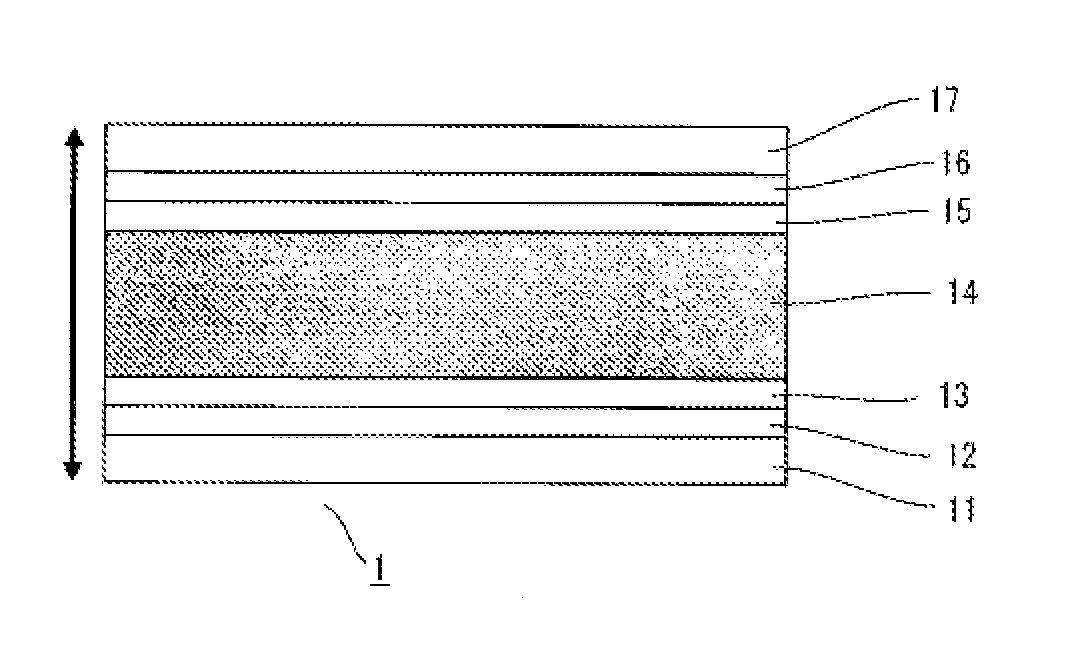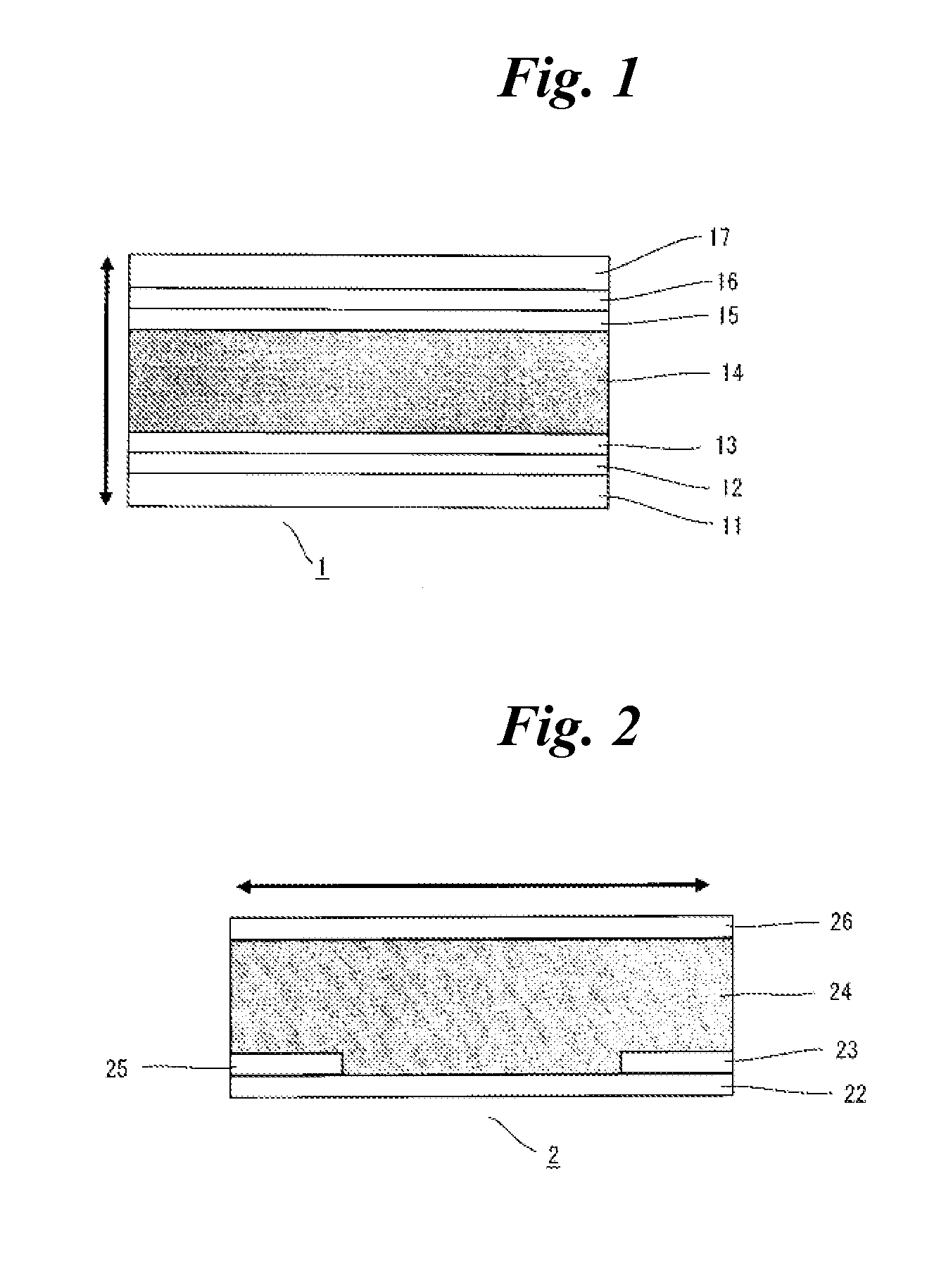Electrically conductive composition, an electrically conductive film using the composition and a method of producing the same
a technology of composition and electrical conductivity, applied in the direction of energy input, sustainable manufacturing/processing, final product manufacturing, etc., can solve the problems of large amount of cost required difficult control of conditions in a producing step, and large cost requirements for a production unit, etc., to achieve excellent electrical conductivity, excellent coating properties, and excellent electrical conductivity
- Summary
- Abstract
- Description
- Claims
- Application Information
AI Technical Summary
Benefits of technology
Problems solved by technology
Method used
Image
Examples
example 1
[0206]To 10 mg of ASP-100F (purity: 95%, manufactured by Hanwha Nanotech Corporation) as a single-walled carbon nanotube, and 25 mg of an electrically conductive polymer 1 shown below, 10 mL of chloroform was added, and the resultant mixture was stirred for 20 minutes by means of a mechanical stirrer. Then, ultrasonic dispersion was performed at 30° C. for 40 minutes using an ultrasonic cleaner (US-2, output: 120 W, indirect irradiation, manufactured by IUCHI SEIEIDO CO., LTD.), and thus a CNT-dispersed chloroform solution was obtained. To this solution, 8 mg of the exemplified compound (I-1) as an onium salt compound was added at room temperature, and thus a chloroform solution of an electrically conductive composition was prepared. Meanwhile, as a substrate, a 1.1 mm-thick and 40 mm×50 mm glass substrate was subjected to ultrasonic cleaning in acetone, and then a cleaned glass substrate was subjected to UV-ozone treatment for 10 minutes. The above-described chloroform solution of ...
examples 2 to 19
[0214]Electrically conductive films were prepared and evaluated in the same manner as Example 1 except that kinds of electrically conductive polymers and onium salt compounds were changed as shown in Table 1. The results are shown in Table 1.
[0215]
Electrically conductive polymer 1:(Weight average molecularPoly(3-hexylthiophene)weight 87,000)Electrically conductive polymer 2:(Weight average molecularPoly(3-dodecylthiophene)weight 27,000)Electrically conductive polymer 3:(Weight average molecularPoly(3-hexyloxythiophene)weight 53,000)Electrically conductive polymer 4:(Weight average molecularPoly(2,5-bis(3-dodecylthiophenyl)weight 79,000)thieno[3,2-b]thiopheneElectrically conductive polymer 5:(Weight average molecularPoly(2-methoxy-5-(2-ethylhexyloxy)-weight 110,000)1,4-phenylenevinylene)
example 20
[0216]An electrically conductive film was prepared on a glass substrate in the same manner as Example 1 except that a CNT-dispersed liquid was prepared by stirring the resultant mixture for 30 minutes using an ultrasonic processor (VCX-502, output: 250 W, direct irradiation, manufactured by TOKYO RIKAKIKAI CO., LTD.) in place of mechanical stirring for 20 minutes and subsequent stirring for 40 minutes using the ultrasonic cleaner (US-2, output: 120 W, indirect irradiation, manufactured by IUCHI SEIEIDO CO., LTD.) in Example 1, and by changing kinds of onium salt compounds as shown in Table 1. This coating film was evaluated with regard to the electrical conductivity, film-forming property, and G / D ratio in the same manner as Example 1.
PUM
| Property | Measurement | Unit |
|---|---|---|
| mean length | aaaaa | aaaaa |
| mean length | aaaaa | aaaaa |
| diameter | aaaaa | aaaaa |
Abstract
Description
Claims
Application Information
 Login to View More
Login to View More - R&D
- Intellectual Property
- Life Sciences
- Materials
- Tech Scout
- Unparalleled Data Quality
- Higher Quality Content
- 60% Fewer Hallucinations
Browse by: Latest US Patents, China's latest patents, Technical Efficacy Thesaurus, Application Domain, Technology Topic, Popular Technical Reports.
© 2025 PatSnap. All rights reserved.Legal|Privacy policy|Modern Slavery Act Transparency Statement|Sitemap|About US| Contact US: help@patsnap.com



